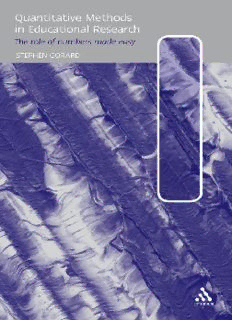
Quantitative methods in educational research : the role of numbers made easy PDF
Preview Quantitative methods in educational research : the role of numbers made easy
Quantitative Methods in Educational Research Also available from Continuum: Bill Gillham: Case Study Research Methods Bill Gillham: Developing a Questionnaire Bill Gillham: The Research Interview Brahm Oppenheim: Questionnaire Design Roy Preece: Starting Research Richard Pring: Philosophy of Educational Research David Scott and Robin Usher: Researching Education Geoffrey Walford: Doing Qualitative Research Jerry Wellington: Educational Research Quantitative Methods in Educational Research The Role of Numbers Made Easy Stephen Gorard Continuum London and New York Continuum The Tower Building 80 Maiden Lane 11 York Road Suite 704 London SE1 7NX New York, NY 10038 © 2001 Stephen Gorard All rights reserved. No part of this publication may be reproduced or transmitted in any form or by any means, electronic or mechanical, including photocopying, recording, or any information storage or retrieval system, without prior permission in writing from the publishers. First published 2001 Reprinted 2007 British Library Cataloguing-in-Publication Data A catalogue record for this book is available from the British Library. ISBN PB: 978-0-8264-5307-5 HB: 978-0-8264-5306-8 Typeset by Paston PrePress Ltd, Becdes, Suffolk Printed and bound in Great Britain by Biddies Ltd., King's Lynn, Norfolk FOR SEE BENG HUAT This page intentionally left blank Contents Lisf of figures ix List of tables xi Abbreviations xiii Preface XV 1 A changing climate for educational research 1 2 Sampling: the basis of all research 9 3 Collecting secondary data: the 'idle' researcher 43 4 Simple analysis: the index wars and other battles 57 5 Surveying the field: questionnaire design 80 6 Simple non-parametric statistics: minding your table manners 109 7 Experimental approaches: a return to the gold standard? 133 8 Elementary parametric statistics: what do they signify? 151 9 Introducing correlations: progress via regression 167 Glossary of selected terms 183 Useful addresses 188 References 189 Index 199 This page intentionally left blank List of figures 2.1 Standard error decreases with size of sample 18 4.1 Frequency of mothers with degrees 1 62 4.2 Frequency of mothers with degrees 2 63 4.3 The 'growing' gap between girls and boys 68 5.1 Draft questionnaire on background to web-based participation 104 9.1 Scatterplot for each local authority: GCSE benchmark 1998 against percentage of children eligible for free school meals 168 9.2 Scatterplot for each school: proportion of students attaining any qualification 1999 against school share of students eligible for free school meals 173
Description: